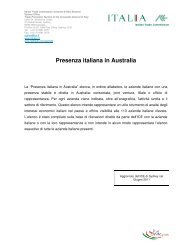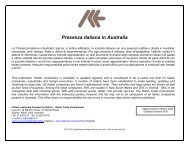Price Determination in the Australian Food Industry A Report
Price Determination in the Australian Food Industry A Report
Price Determination in the Australian Food Industry A Report
You also want an ePaper? Increase the reach of your titles
YUMPU automatically turns print PDFs into web optimized ePapers that Google loves.
The packet flour segment decl<strong>in</strong>ed by almost 1 per cent by value and 2 per cent by volume <strong>in</strong> 2002.<br />
This is a long-term trend and applies to o<strong>the</strong>r cook<strong>in</strong>g <strong>in</strong>puts such as cake mixes and bread mixes.<br />
This reflects <strong>the</strong> fact that consumers are not bak<strong>in</strong>g <strong>in</strong> <strong>the</strong> home but tend to purchase f<strong>in</strong>ished<br />
products from hot bread and cake shops. Given this outlook for <strong>the</strong> sector, <strong>the</strong>re is little<br />
<strong>in</strong>vestment or activity <strong>in</strong> value-add<strong>in</strong>g.<br />
This is different at <strong>the</strong> food service level where bread and cake mix sales to hot bread shops,<br />
pastry and cake manufacturers and o<strong>the</strong>r food manufacturers are strong. In <strong>the</strong>se segments <strong>the</strong>re<br />
is considerable activity <strong>in</strong> new product development us<strong>in</strong>g specialty flours such as soy and rye.<br />
However, despite <strong>the</strong> level of activity, <strong>the</strong>se products represent a small part of <strong>the</strong> overall market –<br />
specialty gra<strong>in</strong>s are estimated to be 5 per cent of <strong>the</strong> volume of wheat used.<br />
Retail prices<br />
The average value of <strong>the</strong> grocery retail market <strong>in</strong> <strong>the</strong> last 10 years has risen from $1.20/kg to<br />
$1.70/kg. However, this is an annual average <strong>in</strong>crease of around 3.5 per cent, suggest<strong>in</strong>g that<br />
prices <strong>in</strong> real terms have decl<strong>in</strong>ed. This reflects <strong>the</strong> decl<strong>in</strong><strong>in</strong>g position of <strong>the</strong> product range and <strong>the</strong><br />
<strong>in</strong>creas<strong>in</strong>g dom<strong>in</strong>ance of private label product. Increas<strong>in</strong>gly <strong>the</strong> pric<strong>in</strong>g and product sourc<strong>in</strong>g<br />
policies of <strong>the</strong> major retail cha<strong>in</strong>s have restricted <strong>the</strong> <strong>in</strong>creases <strong>in</strong> retail prices of private label flour<br />
products.<br />
The chart below shows average retail prices for 1kg packet flour product.<br />
Figure 81. Retail price of flour, 1kg pack, $/kg, 1993–2003<br />
$<br />
2.50<br />
2.00<br />
Melbourne<br />
1.50<br />
Brisbane<br />
1.00<br />
Perth<br />
0.50<br />
0<br />
Q3 1993<br />
Q2 1994<br />
Q1 1995<br />
Q4 1995<br />
Source: <strong>Industry</strong> sources<br />
Background<br />
Wheat for mill<strong>in</strong>g is a major part of <strong>the</strong> gra<strong>in</strong>s <strong>in</strong>dustry and traditionally has been seen as <strong>the</strong> high<br />
quality end of <strong>the</strong> market, that is, seek<strong>in</strong>g prime hard or specialist categories of wheat such as soft<br />
wheat. However, as technology advances are made <strong>in</strong> areas such as bread improvers, <strong>the</strong> quality<br />
of <strong>the</strong> wheat <strong>in</strong>put is becom<strong>in</strong>g less of an issue. Bread manufacturers are seek<strong>in</strong>g ways to reduce<br />
raw material prices and utilis<strong>in</strong>g lower quality wheat is one means of achiev<strong>in</strong>g this.<br />
Retail pric<strong>in</strong>g<br />
Q3 1996<br />
Q2 1997<br />
Q1 1998<br />
Q4 1998<br />
Q3 1999<br />
Q2 2000<br />
Q1 2001<br />
Our analysis of <strong>the</strong> marg<strong>in</strong>s captured by each major sector engaged <strong>in</strong> <strong>the</strong> flour value cha<strong>in</strong> is<br />
represented <strong>in</strong> <strong>the</strong> chart (note this applies to retail packaged flour only). This has been compiled<br />
by reference to <strong>the</strong> average retail value of retail flour product <strong>in</strong> <strong>the</strong> <strong>Australian</strong> market (per ABS<br />
data), <strong>the</strong> average net sell<strong>in</strong>g price achieved by <strong>the</strong> domestic miller/marketer and <strong>the</strong> farmgate<br />
return based on average prime white grade wheat delivered port prices adjusted to farmgate.<br />
Q4 2001<br />
Q3 2002<br />
Q2 2003<br />
<strong>Price</strong> <strong>Determ<strong>in</strong>ation</strong> <strong>in</strong> <strong>the</strong> <strong>Australian</strong> <strong>Food</strong> <strong>Industry</strong> A <strong>Report</strong><br />
77







